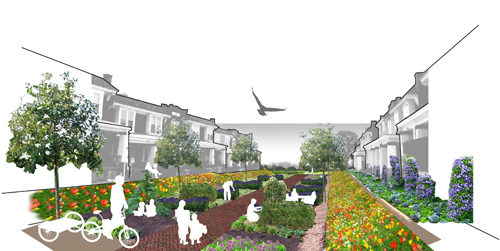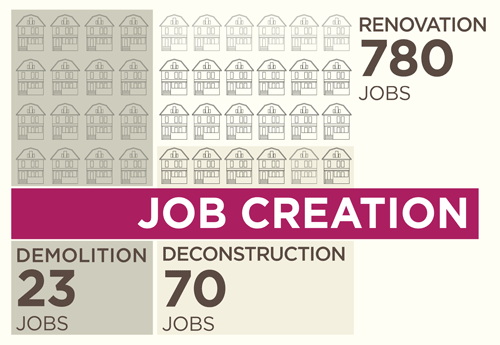Urban Strategies: Rethink Boundaries
Have you ever wondered how there came to be 67 counties in Pennsylvania? Back in the 1800s the counties were largely delineated by a day’s horse ride, which made a lot of sense 100 years ago. Now we get from county to county within an hour. Today, each county has a different governance structure and priority assessment. Similarly, we have another 130 municipalities within Allegheny County. Beyond that there are innumerable additional regional and local agencies, utilities, and legislative bodies throughout the state of Pennsylvania. As a result, we’ve created many boundaries and lots of red tape when approaching planning using new approaches or perspectives.
Rethinking these boundaries is a key step in introducing sustainable urban strategies. Let’s look at how we can reevaluate physical, governance, techonological, and financial boundaries.
Physical
Defining community using ecological principles
Our urban centers have largely obfuscated our ecological systems to a point that they are largely invisible to the average city dweller; our approach to planning over the past 50 years often reflects the concept of altering and eliminating nature, an approach that is in stark contract to participating with our natural resources. This approach to planning is now widely recognized as a false and shortsighted choice. Instead, a more appropriate plan for the long term is to explicitly understand the varied ecological services and resources within respective communities. Only then can we determine the appropriate indicators for long term improvements.
In our green overlay proposal for the Low Carbon Neighborhood Improvement District, we suggested that it is possible to apply sustainable principles to the traditional planning processes. We developed a process in which a green planning ‘overlay’ is combined with crucial neighborhood indicators such as neighborhood safety and local business growth. Together, they illustrate how ecological services and community resources can serve to further leverage these existing indicators. Here are two examples to consider:
If neighborhood safety is a key indicator for a community’s improvement, how might the addition of street trees, expanded pervious sidewalks, stormwater rain gardens, or bioswales slow neighborhood car traffic and enhance walkability? Or how might business growth be promoted through an option to tie into a distributed renewable energy source; providing reliable energy at predictable rates over the long term? In both cases, traditional neighborhood metrics for improvement can be significantly impacted by a better understanding of natural resource surpluses (geothermal capacity) and deficits (regional stormwater overflows lead to increased utility costs).
We must rethink the capacity of our local ecology to provide community benefit. We must also determine how existing mistreatment of an ecological resource can lead to environmental deficits and increased monetary costs. We need to re-draw our community and infrastructural boundaries in ways that support the long term vibrancy of ecological conditions. Ecology and natural resources must serve as the foundation to this approach — eco-districts emphasize a logical approach to rethinking our communities based on physical assets and potential.
Governance
Building capacity and developing partnerships

Living Cities Masterplan – A new model of managing resources differently creates new opportunities for the farming community
Thus far we’ve explored some of the physical requirements of an ecodistrict, and while they are important, the development of low carbon communities will not happen without addressing other, perhaps more important, factors related to existing governance-related boundaries. We need to reduce the soft costs of green infrastructure development.
- Some existing barriers we might consider removing:
- Easing the requirements associated with capturing and treating stormwater for non-potable uses onsite.
- Allowing industrial waste energy to be sold back to the grid or local consumers, and allowing for easier development of localized energy solutions from solar permitting to small scale power generation.
- Establishing waste management strategies that eliminate the need for centralized landfill.
- Promote and educate consumers as to the advantages of localized resources.
In every example mentioned above the largest barrier to implementation is often not the lack of a cost-competitive technology, but is often related to regulations, ordinances, and lack of legislative approaches to alternative distributed community-based solutions.
This issue of governance requires an adjustment of the dialogue between local leaders, service providers, and consumers. It calls for planners to advocate for solutions and play a role of partnership seekers and capacity builders. Over the next 20 years we will need to engage all of the potential bridge technologies that will transition us toward a low carbon future. Many of the technologies most readily available for increasing the efficiency of our energy and water services sector aren’t as widely discussed as solar or wind simply because our leading policy makers don’t understand how they are most effectively deployed.
Technological
Use that which is available, plan for the future

Living Cities Masterplan – Utilizing phased technological advancement, this plan creates a net-zero energy community
When it comes to green technology there’s no shortage of product research and development in the marketplace. The annual influx of capital across all sectors of the greentech economy is ever increasing. Products such as LED lighting, solar panels and geothermal heating and cooling systems are providing largely environmentally benign solutions to our toughest energy related challenges. Yet, among the aforementioned, we often forget that even with an ever-improving cost competitiveness, none typically have rewarding mid-term paybacks. So even as costs continue to drop, those product solutions don’t yet represent opportunities for short and mid term change. Enter the concept of bridge technologies: off-the-shelf interim technologies that are marginally greener than traditional products. Think hybrid vehicles, CFL lighting, high effciency boilers, or recycled-content plastics. All represent better alternatives to their traditional counterparts and they exist and are required in almost every industry and sector in order to achieve long term sustainability goals.
These bridges represent a key midterm solution for more complete sustainability solutions. It is important to investigate and prototype the potential for living buildings or cities, zero emission vehicles, and truly renewable, environmentally benign energy, but is also important to pursue existing technology best practices. Even if solar panels were the cheapest form of energy; we simply don’t have infrastructure in place to switch in even a five year time period. From a community planning perspective there are a number of implications to this issue of technology. Communities must work to implement low cost solutions immediately and plan for deployment of higher cost solutions over time.
In our work we’ve been privileged to have the opportunity to envision how both scenarios might be achieved. The first, Friendship Green, focused on a five year plan in which bridge technologies were a primary mechanism for deployment toward a greener community. Initiatives such as whole house insulation loans, smart meter competitions and lighting retrofits were all considered. The second Living Cities Masterplan, allowed us to envision a future in which the bridge had been crossed, where a community might actually be capable of serving its 6,500 constituents with renewable energy, local and water, and a truly vibrant ecology.
Financial
Create a vision and understand resources needed to meet that vision

Living Cities Masterplan – New economic models can provide new jobs opportunities while rebuilding our communities
Everything we’ve discussed sounds great in theory, but what good are these concepts if they can’t be applied easily to existing communities? And just as importantly, what are the obstacles to implementation?
Often they are financial. We’d be remiss to simply ignore the fact that community improvement always carries associated financial costs. This is especially important because, in many instances, communities or neighborhoods aren’t always set up to access or deploy financial resources for improvement aspirations. Often they rely on large funding streams as they only represent a piece of a larger jurisdictional or tax pool. But communities of this kind (or size) aren’t simply stuck; any community willing to organize and build capacity can access funding. We’ve been actively exploring a number of potential mechanisms for sustainable community planning and implementation. Concepts such as community financed revolving loan funds or state Business/Neighborhood Improvement Districts or federal Community Block Grant funding streams are all well aligned with long term sustainable community development principles. Any community looking to improve the prospects for attraction of local businesses or new residents must reconsider traditional planning boundaries.
The successful development of a green neighborhood or ecodistrict won’t be without its challenges, they won’t happen overnight, and a community dedicated to the idea will face obstacles or unexpected challenges. Too often, perceptions of the past inhibit communities from envisioning a different future.
It is our hope that a simple re-thinking of commonly perceived challenges and boundaries opens the door to new and very real possibilities for our communities. Ecodistricts offer a distinctly different and better vision of that future.

